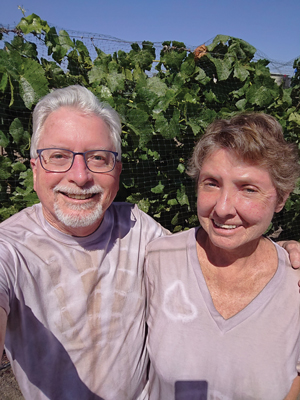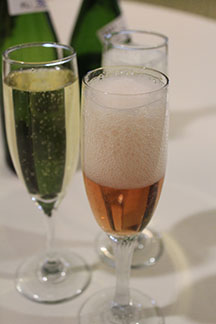Mostly, we make wine at home to enjoy drinking it. We share it with friends and family, make pairings with special foods, and maybe even take it along to a potluck party to let new friends try a taste. Beyond the delightful consumption of our wonderful adult beverages, we may also enter them in competitions, perhaps winning medals or ribbons while gaining valuable feedback on our work. But is one hobby ever enough? Today we will visit other DIY things to do with some of your homemade wine.
Vinegar
Homemade vinegar is an obvious starting point. Making wine vinegar is one of the simplest hobby extensions out there. Buy yourself a wide-mouth gallon (3.8-L) jar and an eight-ounce (237-mL) bottle of vinegar starter or “mother.” The mother is simply a stable live culture of Acetobacter bacteria, the aerobic microorganisms that turn ethanol into acetic acid. Pour the mother into the gallon (3.8-L) jar and, using the bottle the mother came in, add two measures of homemade wine plus one of chlorine-free water. Adding the water lowers the alcohol level to make it easier for the bacteria to get started.
Use a red-wine mother to make red wine vinegar or a white-wine mother for white wine, Champagne, cider, or malt (beer) vinegars.
Cover the gallon (3.8-L) fermenter with clean muslin to keep dust out but allow air in. Set in a warm place (not your winemaking space!) and allow to sit for a month or two. When it smells like vinegar, it’s vinegar. You can take out some and replace it for a new batch with diluted wine, or go ahead and build up to a full gallon (3.8 L) by adding 2 quarts (1.9 L) of wine and 1 quart (0.95 L) of water. In another month or two, you will have vinegar again, suitable for bottling and using or sharing with winemaking friends to help them make vinegar, too. Mothers are typically available in white wine and red wine, with color being the only distinction. Use a red-wine mother to make red wine vinegar or a white-wine mother for white wine, Champagne, cider, or malt (beer) vinegars. A final thing to note is that it is advisable to use separate equipment for vinegar instead of your usual winemaker funnels, bungs, or the like.
Aperitifs
A beverage extension you can add to your winemaking is to turn some of those wines into aperitifs. Served alone at cocktail hour or blended into cocktails with other ingredients, such liqueurs offer a wide range of fruity and spicy aromas and flavors. The basic method I use is to infuse selected spices and fruits in enough high-proof alcohol to provide the fortification of my dry wine up to typical aperitif level of around 16 to 20% alcohol by volume (ABV).
After a week or so of soaking, I run the extract through a coffee filter and add it to my wine. The ratio of wine to infused spirits is calculated using the Pearson’s Square formula. For details on that, and suggestions on making sweet vermouth and an entirely original cranberry beverage, check out my article at https://winemakermag.com/article/aperitifs. After you make either a classic or original aperitif, exercise your creativity further by mixing up some cocktails. Family and friends will be happy to help you evaluate them.
Distillation
If you are fortunate enough to live in a place that allows home distilling, brandy provides another beverage option to extend from your winemaking. In the U.S. or Canada, you need a license or permit from the government, but there are locations where home distilling is a popular hobby. If you get a still, be sure to follow the manufacturer’s instructions when using it. Those instructions will generally include discarding the first and last portions of distillate, which will respectively be higher in methanol and fusel alchohols than the rest of the product. If you are distilling homemade wine that is about 12% ABV, each 750-mL bottle holds the potential to yield about 90 mL (3 oz.) of pure alcohol.
At the lowest boiling point for a solution of water and alcohol — like wine — the ethanol in the distillate is about 96%. You can check the actual results from your still with a proof and tralle hydrometer, which works like the sugar hydrometer you already use for fermentation. For barrel aging, the raw alcohol from the still is often diluted or “cut” with pure water to about 70% or 140 proof. The “brandy” is clear and colorless from the still and acquires its brown color and oaky, vanilla flavors from aging in a charred oak barrel. With all that in mind, if you want to fill a 5-gallon (19-L) charred oak barrel with 140 proof brandy for aging, you will need to distill about 149 bottles or 121⁄2 cases of wine. Yes, that’s a lot of wine, but if you then cut the aged brandy to 86 proof (43% ABV) with pure water for pleasant consumption, your little barrel of high proof will yield about 8.2 gallons (31 L) or 41 750-mL bottles of finished brandy. Alternatively, charred oak alternatives can be used if a barrel is not available.
Cooking With Wine
Moving beyond beverage applications, there is a whole world of marinating and cooking possibilities for your homemade wine. There are long-time classic dishes that even include wine in the name, like beef bourguignon and coq au vin. Instead of Burgundy in the former, I use my own estate-grown Pinot Noir. And when my wife, Marty White, makes coq au vin, she likes to use a white wine instead of red, especially if I have a homemade Viognier or Sauvignon Blanc in the cellar.
Whenever I make a stew with beef, lamb, or veal I add a half-cup to a cup (118-237 mL) of red wine to it. When Marty makes red meat sauce for spaghetti or lasagna, she does the same. My chicken piccata sauce always includes a little bit of white wine along with butter and lemon juice. I also like to use white wine to deglaze the roasting pan for chicken or turkey gravy. Because I have a rosemary bush growing just a few feet from my gas grill, I like to tie some sprigs to the handle of a wooden spoon with kitchen twine to make a rosemary “brush.” Then I use that to apply a mixture of red wine and butter to lamb chops as they grill. For that one, I look for the heaviest homemade red wine in my cellar, currently a 2015 field blend of Zinfandel and Petite Sirah.
Cheesemaking
I also like to use a deeply colored red when I make a homemade cheese with wine. This category of cheeses is sometimes called “drunken cheese” to indicate that it has spent time in a bath of wine or other alcohol. Cabra al Vino is a mild, semi-hard pressed cheese made from goat’s milk and aged in red wine. Since Marty doesn’t like goat’s-milk cheese, I developed a similar recipe I call Queijo de Vinho using cow’s milk. The tangy, wine-soaked outer surface contrasts beautifully with the firm white curd when you cut into it and the wonderful pairing of wine and cheese is right there in one dish. Both recipes can be found at the website of the fermentation store where I used to be part owner, www.thebeveragepeople.com. To find them, click on Menu, then How-to & Recipes, then Cheesemaking, and finally Cheesemaking Recipes. Elsewhere, you can find home cheesemaking recipes for versions that soak the curds in red wine first, then press them into a beautifully marbled wheel. If you really want to get adventurous, you might try a home version of Italy’s Occelli al Barolo. That cheese is aged for several months, then for two more months after coating with pressed Barolo grape must. As a home winemaker, you may have an opportunity to make this truly unique food product since you have leftover grape must and most of your friends and neighbors do not.
Homemade Sausage
Another of my favorite hobbies that includes some homemade wine is making sausage. I covered my basic techniques and included a couple of recipes in the August-September 2021 issue of WineMaker. Not all of the sausages I make include wine, but many do. Most sausage recipes include a small amount of added liquid. In the magazine article, that was red wine for both Italian sausage and Portuguese sausage (linguiça). If I am not adding wine, there’s a good chance I will be adding homemade beer or vinegar instead. To make link sausages at home, you will need a grinder and a stuffer, or a combination unit that does both. Most recipes are similar. You cube, season, and grind meat and then stuff it into casings. From there, sausages may be smoked, dried, or just cooked from fresh or frozen. If this hobby intrigues you, check out that previous article https://winemakermag.com/article/making-sausage-at-home.
Fashion?

As I was making a list of the hobbies that I use wine in, Marty suggested a new one: Wine tie-dye! Sure enough, it’s a thing. We found a guide for using red wine to make your own customized tie-dye T-shirt on the website of a familiar winery. When we attended the 2019 WineMaker Magazine Conference in Traverse City, Michigan, we made a point of visiting some local wineries to do some tasting. One of those was Chateau Grand Traverse, a few miles north on the Old Mission Peninsula from Traverse City. We had a lovely tasting experience, enjoying the views of their vineyards and grounds. So when we went looking for a guide to wine tie dying, we were delighted to find this link: https://cgtwines.com/diy-tie-dye-wine-chateau-grand-traverse/.
We started with a couple of new 100% cotton T-shirts and used rubber bands to make patterns on the shirts. I went to the wine cellar to find a nice, dark wine and decided on the Zinfandel/Petite Sirah field blend previously mentioned. Although Chateau Grand Traverse notes that you can use some leftover wine, we wanted to make sure we got enough depth to submerge both shirts. I poured four bottles totaling three liters into a 4-quart stainless steel pot. We boiled the wine, turned off the heat, and sank the shirts. After six hours of soaking, we took them out to dry. Over the next few days, we followed the rest of the steps of ironing, rinsing, and hand-washing in Woolite. We are very happy with the results and you can see us modeling them in our vineyard in the photo included at the top of this page.
That’s all the wine-using hobbies for now, but I’m sure more will come up in the future. I’ll keep you posted.






